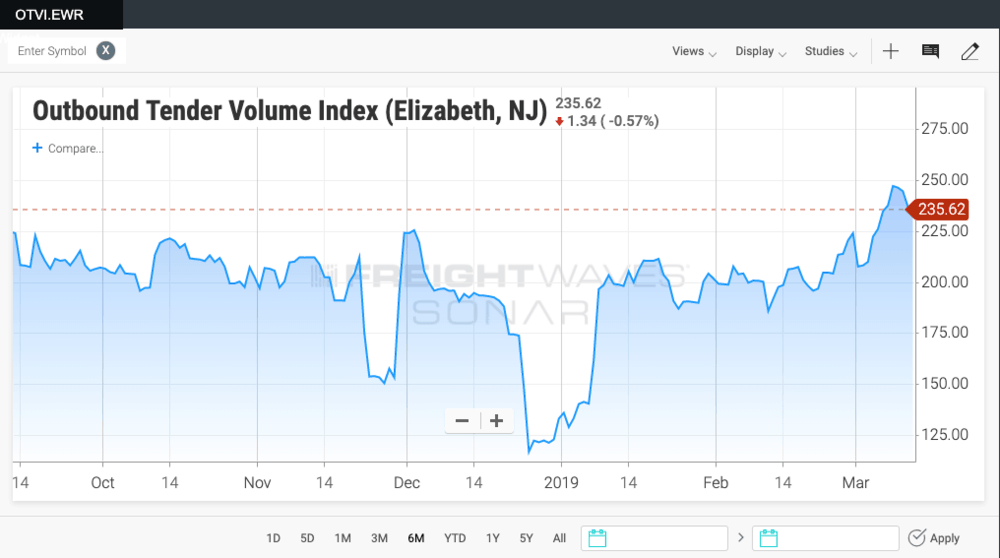Volumes continue to remain strong even during seasonal slow patch and trucking capacity still remains tight in the region.
The Port of New York and New Jersey is seeing truck turn times improve and delays lessen as terminals there work down the January backlog of containers. But drayage capacity still appears tight as local logistics executives see strong volumes of containers coming through the port.
Trucking companies report that New York and New Jersey terminals are getting between 60 percent and 80 percent of container movements done in two hours or less. That compares to drivers reporting extreme instances of container moves taking between four and eight hours, with one driver saying trucks were queued “all the way to the Turnpike” during parts of January.
The delays were the side effect of the record volume of containers coming into the U.S. The Port Authority of New York and New Jersey reported its fifth best January ever with total volume reaching 622,531 twenty foot equivalent units (TEUs), a 6 percent rise from a year earlier and a 2 percent gain from December.
Shippers remained in a rush to move freight into the U.S. ahead of yet another delay in the imposition of tariffs, with inbound loads of 327,345 TEUs being the third highest monthly total on record and 6 percent higher than a year ago.
The volumes coming in are also being matched by large amounts of empty containers, totaling 183,353 TEUs, up 11 percent from a year earlier.
Backhaul volumes remain largely flat at 111,833 TEUs for the month. The Lunar New Year slowdown makes it difficult for volumes to sustain that growth through February and March. But local trucking sources said they continue to see strong volumes. Likewise, one terminal executive said, “we are doing lots of volume right now.”
But even with less congestion, drayage capacity remains tight. An terminal executive said they have been able to move only about half of the import containers in their yard, even with extended gate hours, due to less drayage supply. And backlogs are still episodic with some terminals having to divert ships to less-impacted terminals.

Terminals are trying to get ahead of the next peak shipping season with planned upgrades. Logistics executives in the area point to APM Terminal New York’s move to add additional yard equipment for handling containers and a truck appointment system. The upgrades, which will be rolled out through the second quarter and third quarter, are expected to improve truck turn times at the terminal. An APM spokesperson was unavailable to comment on the upgrades.
Guidelines issued for monitoring ocean plastic
IMO issues rules as five to 12 million tons of plastics enter oceans every year. (Maritime Executive)
Sunken Grimaldi ship now leaking oil
Oil slick now seen in Bay of Biscay near the Grande America casualty. (gCaptain)
Experts put price on container ship scrubber use
Box ship rates may have to increase $200 per TEU container to finance scrubbers. (Seatrade Maritime)
Rio de Janiero suspends Vale terminal operations
Guaiba Island Terminal operations suspended due to water run-off and accidents. (Safety4Sea)
Brexit poses risk to cargo at seas
The United Kingdom’s status within the European Union remains unclear after the country’s politicians block any path for the country to follow through on its pledge to hive itself off from the rest of Europe. As FreightWaves Nick Savvides reported, the country’s parliament voted against a so-called “hard Brexit”, which would leave the island nation with no sort of concession or agreement with its largest trading partner. But just a day earlier, the Parliament voted down Prime Minister Theresa May’s attempt to reach a deal through a so-called “soft Brexit”, which aimed for some concessions. So what’s a shipper to do, given the flux in the U.K.’s withdrawal from the E.U.? Maersk said in a customer notice that “it is possible that no deal will be reached, implying a ‘hard Brexit’ scenario.” This means that shippers from the U.K. will be subject to customs clearance, tariffs and duties, and other formalities of trade with a member of the E.U. Outside of the E.U. U.K. shippers face will have to abide by the the general rules of the World Trade Organization. The tricky part for shippers will be in the timing of freight being loaded and when it arrives, though. Goods that are shipped prior to the expected Brexit date of March 29, but arrive after that date will be subject to the hard Brexit conditions for tariffs and customs clearance.











